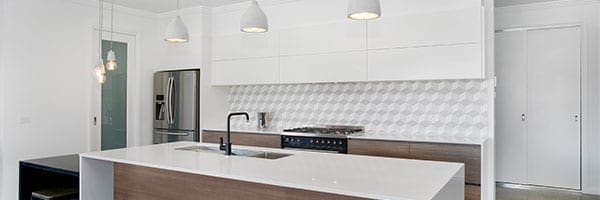From baking with the kids to enjoying a catch-up session with friends, new kitchens planned to optimise the use of space will allow all users to enjoy the hub of the home.
The kitchen is often the heart and soul of a family home. When building new kitchens there are some fundamentals that should be followed to ensure everyone can enjoy the space. This is a principal we call universal design and it enables people of all ages and abilities to thrive as comfortably as the next.
A new kitchen designed for ultimate space and functionality will provide a safe and aesthetically-pleasing environment for years to come. Here are our space and design layout tips to consider when planning your new kitchen.
Entry Points
Although open-planned kitchens are popular these days, new kitchen designs featuring doors or a smaller entry point are still quite common. French doors and bi-folds are trending additions to new kitchen designs.
If you favour an entry point over an open-planned kitchen, be sure to consider the following:
- The comfortable minimum width for a doorway entry is 82cm (32 inches)
- Leave enough space between the open door and any appliances or fittings (e.g. consider the space needed for an oven door or microwave door, etc)
Bench Space
Ample bench space is one of the most important design features in new kitchens. But, how do you know when enough is enough? We have put together some basic rules to help take the guessing game out of designing your new kitchen bench space.
Length of benchtop
We recommend a minimum total of 4 metres for benchtop space.
Edges
Consider rounded or clipped edges as opposed to sharp, 90-degree edges as these can lead to an increased risk of cracking in the benchtop itself. They are also slightly kinder should you, or your family and guests, happen to bump into them.
Benchtop depth
Benchtops should measure at least 61cm back from the edge of the benchtop to the wall or splashback.
Area above the benchtop
To comfortably accommodate appliances like coffee machines, thermomixers and over-sized blenders, ample space needs to be offered between new kitchen benchtops and any overhead cabinetry. We recommend a minimum area of 45cm between the benchtop and the underside of any overhead cabinetry.
New kitchen sink
There might not seem much to the decision-making process of a new kitchen sink; but think again. Sinks come in many forms – round, square, rectangular, as well as different colours and materials. Once you have narrowed in on the type of sink to use, here are some placement guidelines to consider for your new kitchen sink.
Install a new kitchen sink adjacent to or opposite the main cooking surface and refrigerator.
It is also important to ensure that your sink location allows for adjacent bench space. This is referred to as a landing area and provides appropriate resting places for food items and utensils whilst cooking. This landing area should be no less than 61cm on one side and 48cm the other side.
In addition to this minimum, we recommend another 90cm of benchtop space next to the sink which can be used as prep area for cooking in your new kitchen.
Oven or Stove
The sink is not the only area to need adjacent landing space, however landing area is more of a safety precaution when associated with an oven or stove. We all know these appliances are extremely hot and can involve flames and gas. A landing area next to your major appliances offers a place to set down hot pots and pans whilst cooking.
In a new kitchen, we recommend a minimum of 38cm on either side of the oven and stove. These amounts are bare minimum and should be extended if the space is available (considering how large some cooking pans are).
Rangehood
A minimum of 65cm should be dedicated to the vertical space between a cooktop and a rangehood, or 70cm if the cooktop is gas.
The Kitchen Triangle
The three main working areas of a new kitchen, or any kitchen for that matter, are the cooking area (oven and stove), sink and refrigerator. These three areas form what is known as the kitchen triangle. The three points should be non-impeded and not too far from one another.
It is recommended that all three paths of the triangle not exceed 8 metres in total length and fall between 1.2 – 2.7 metres each in length. These distances between each key station should be straight and free of any impediments.
Any extra preparation areas, such as a microwave, should be between 1.2 – 2.7 metres from the nearest point of the working triangle.
Space and Flow of Traffic
A new kitchen should be planned out with a minimum of 1.0 – 1.5 metres of space between benches. This provides enough space for two people cooking and extra allowance for anyone who might be in a wheelchair or with a walker. A u-shape kitchen should provide 1.5 metres of clearance between benches to allow a turning radius for a wheelchair.
For traffic flow (and wheelchair access) 1.5 metres should also be the amount of open space made available behind any seats at a breakfast bar or island bench.
You should refrain from blocking any work aisles with obstacles. Work aisles are invisible paths used by cooks in the kitchen to access the working triangle of the new kitchen.
On the contrary to work aisles, walkway aisles should be dedicated to the flow of traffic outside the main kitchen working area. No walkway routes should pass through or obscure the kitchen triangle area. The minimum width we recommend for a walkway route is 90cm.
Power outlets
In our high-tech world, new kitchens these days are home to items like chargers, hands-free speakers and docking stations amongst the usual kitchen cooking appliances. So it is important that you consider incorporating enough power outlets into your new kitchen design to accommodate for these.
You could think about installing power outlets inside kitchen cabinetry. Appliances like toasters, kettles, your latest Google Home Mini and all those necessary chargers can be concealed neatly without contributing to a mangled mess of cords on your new kitchen benchtop!
Be sure to consider these key elements for the ultimate new kitchen design.
The design experts at Harrington Kitchens can help with planning your new kitchen, including making the most of your kitchen space. Contact us today, call 1300 662 112 or visit us at our Narellan and Bowral showrooms.


Recent Comments